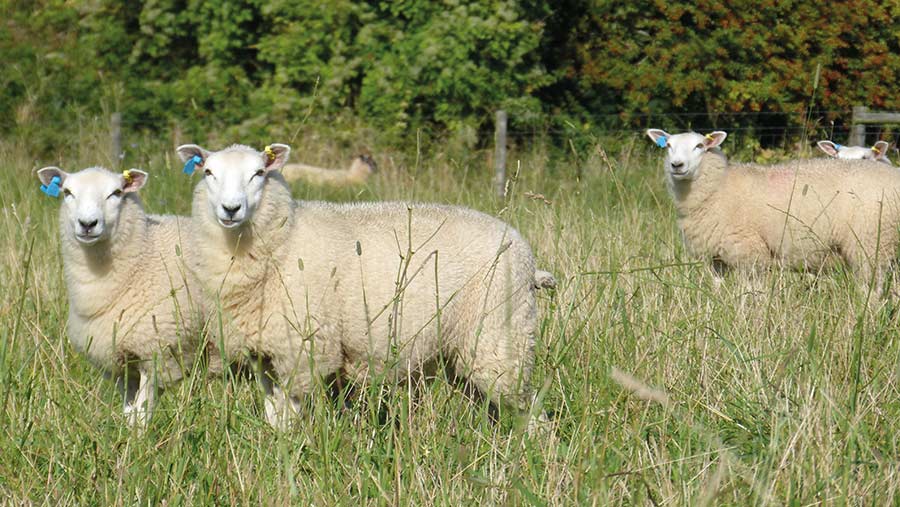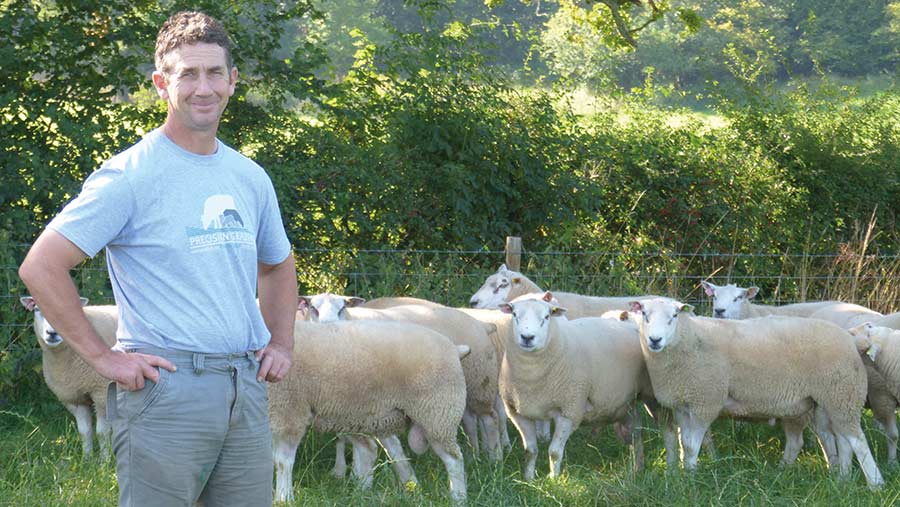Dorset outdoor lamber lifts scan 20% with Belclare
 © MAG/Michael Priestley
© MAG/Michael Priestley Taking a gamble on an Irish sheep breed has paid off for one Dorset breeder, who has increased flock output 20% and developed an additional income stream selling rams.
Mike Miller of Mount Pleasant Farm, Woolland, in the Blackmore Vale, says investing in Belclare genetics six years ago has brought prolificacy and improved carcass quality in his cross-bred flock.
The Belclare is a composite breed specifically developed by Irish researchers looking for an all-round performer with high prolificacy. Irish lowland flocks use Belclares to lift scanning rates, particularly in the Suffolk-cross ewes – the core of Ireland’s sheep flock.
See also: All-grass wintering could save sheep farmers £15 a head
Farm facts
Mount Pleasant Farm
- 141ha (350 acres) farmed in total
- 70ha (175 acres) owned at home, mostly lowland heavy clay land
- Hillier, more free-draining land on 40ha (100 acres) on annual grazing agreement and 28ha (70 acres) taken on and farm business tenancy
- 470 ewe and 200 ewe lambs
- Contract rearing 90 dairy beef cattle on a Blade Scheme for Sainsbury’s
- 55kW biomass boiler
- Five glamping tents
- 20 Simmental-cross Angus suckler cows
- Prime lambs sold to ABP
Why Belclare?
Mr Miller’s lowland flock of New Zealand Romney and Suffolk crosses has scanned at 194-200% since Belclares were introduced in 2015.
This is 20% higher than before and means an extra 80 lambs can be sold at 1.64 lambs reared a ewe tupped, with 15% mortality in an outdoor lambing system.
And despite the breed being scarcely known in the UK, the amount of data behind the breed allowed Mr Miller to have a degree of faith in what he was buying.
All rams are genotyped and performance recording has been a breed rule for decades.
“While Irish farms tend to lamb indoors, I felt I could breed a small, compact ewe to lamb outside and outwinter while maintaining prolificacy,” says Mr Miller, a Nuffield Scholar who studied all-winter grazing for sheep.
“After a few years, I’m about there, and people I’ve sold to have found they work.”
Being a relatively small farm, Mr Miller used the Belclare to improve output without having to feed for it.
Mineral buckets are only bought during late springs when grass isn’t sufficient, such as in 2019.
Otherwise, no hard feed, buckets or blocks are bought for the ewes or lambs – sheep must perform off grass. The only main purchased input is 3t of fertiliser (which is mainly for fodder beet).
Belclare facts
- 99% of the ram population and 67% of the ewe flock is genotyped
- All Belclare animals are performance recorded – data has been analysed by an independent organisation (Sheep Ireland and Teagasc before that) for 30 years
- More than 3,700 Belcare animals have been genotyped in total
- 3,000 lambs were recorded from birth in 2021
- Currently, Belclares are about 37% Texel, 25% Lleyn, 18.5% Finnish Landrace, 7% Galway and 12.5% high prolificacy (Irish cross-bred)
- The breed was developed at the Belclare research centre in County Galway
Source: Kevin McDermott, manager at Sheep Ireland, and Tim Keady, Teagasc sheep researcher and consultant
Instead, the system relies on the good, dairying-type ground and the “golden 20” rule for the 10 days before and after tupping.
This rule works by getting ewes at target body condition score (3-3.5) and offering lean ewes the best grass.
Sheep are moved daily with fences for the 10 days before and after the tups go out, ensuring the highest-quality grazing is offered.
As well as prolificacy, the flock has benefited from heterosis, improved growth and carcass, which comes from the Texel influence, explains Mr Miller.
He now uses Belclares predominantly across the flock, with some other New Zealand Suffolks and Romneys.
“I was finding the Romneys would grow well to 30kg and then just steady up on our land. This doesn’t seem to be a problem anymore. Grading has also improved, I don’t see O grades anymore. Now lambs achieve R grade or better.”
And, with very little known about the breed in the UK, Mr Miller saw an opportunity to become established as a Belclare breeder. He already has regular outdoor lambing customers and sells shearlings off grass for about £650 a head.
Getting started
Mr Miller first visited Belclare breeders to see what was available and searched the Sheep Ireland database to see which flocks rated highly on the Sheep Ireland star rating.
A five-star rating is given for terminal and replacement ability to allow comparison within breeds and a numerical euro (€) figure is used to compare across breeds (see table below).
How Belclares perform for terminal and replacement index |
||
|
Breed |
Top 100 Belclares |
Top 100 Texels |
|
Terminal value |
€1.56-€2.50 |
€1.86-€3.84 |
|
Breed |
Top 100 Belclares |
Top 100 Lleyns |
|
Replacement value |
€7.38-€8.64 |
€4.66-€6.54 |
| Note: Use of euros in this table acts as an index, not a cost or a price. | ||
Mr Miller has bought shearlings and in-lamb ewes from Larry Barrett of the Kilmeany flock and John Renehan of the Violet Hill flock.
“Both these flocks had four- and five-star animals and were commercially focused,” says Mr Miller.
“Larry was very helpful as he had worked for the Department of Agriculture and helped with the exportation paperwork.”
Two shearlings were initially bred to the Romney and New Zealand Suffolk cross ewes in 2015.
Three batches of ewes in-lamb with triplets and twins were then imported in 2016, 2017 and 2019.
After some artificial insemination and embryo transfer work, the current Belclare flock stands at 87 ewes and about 30 ewe lambs to tup.
Data recording
Mount Pleasant Belclares are recorded with Sheep Ireland and all rams are genotyped.
This is done with an ear-tissue tag, which is sent to Sheep Ireland and combined with an official scrapie test.

© MAG/Michael Priestley
The test is subsidised, costing £15 a time. This is done on ram lambs in October to avoid fly aggravation around the ears.
“It’s easy for mistakes to happen in sheep breeding,” says Mr Miller. “But even stock rams are genotyped. What you see is what you get with this breed.”
Sheep suit low-cost system
The Belclare sheep are managed with the rest of the ewes at Mount Pleasant. This is how Mr Miller has challenged the genetics to see which ones perform off forage alone.
Mature ewes weigh about 68kg, which is slightly lighter than the 70-80kg Belclares in Ireland. Mr Miller has tried to limit ewe size to allow for higher stocking rates.
All ewe lambs hit 40kg by November without concentrate ready to be tupped. They scanned at 110% last year.
The Belclares can also thrive on an outwintering system. Last winter, fodder beet held 350 ewes for a cost of £6 a head for 100 days or so, budgeting 1.5m (three rows) of beet/day.
At 22t dry matter (DM)/ha, this cost 3.9p/kg of DM last year (includes rent). The beet yielded 20t DM/ha the year before. Fodder beet follows old grass leys on free-draining land.
A crop of oats undersown with a herbal ley followed the beet. This yielded 30 bales/ha (12 bales/acre) of oat silage this summer with no nitrogen and has then given a high-quality feed for lambs for four years or so.
Spring grass is rested for three or four months for when sheep lamb at grass for 30 days from late March, meaning no conentrate is fed. This means Mr Miller can market his Belclares as concentrate-free sheep.
